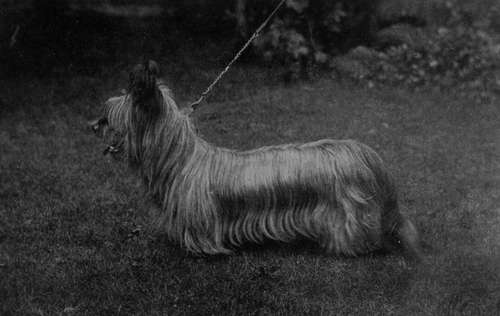Section F. Chapter XIII. The Skye Terrier
Description
This section is from the book "Sporting Dogs. Their Points And Management In Health, And Disease", by Frank Townend Barton. Also available from Amazon: Sporting Dogs; Their Points and Management in Health and Disease.
Section F. Chapter XIII. The Skye Terrier
These little Terriers are natives of the Island of Skye and adjoining coast, though by what means the breed was originally produced there does not appear to be any accurate data to go upon. The Skye is the only truly long-coated Sporting Terrier in Great Britain, cross-bred dogs excepted.
The introduction of this long coat into a Terrier— dogs originally bred for rough-and-tumble work, can hardly have been advantageous, and the remarkably profuse coats of typical specimens in the present day is absolutely detrimental for work; moreover, it requires very careful grooming to keep the coat in a perfect state, though the texture of the hair being much harder than the silky coat of the Yorkshire Toy, gives less trouble than the last named.
Skyes are divided into " drop "-eared, and "prick "-eared, the chief differences being the carriage of the ears and tail. The drop-eared has a little longer and softer coat, longer body, and slightly smaller head; in all other respects they are practically the same. They are generally very game little Terriers, and will hold their own, weight for weight, in combat with any dog. Are good companions ; of good constitution,and not given to quarrelling, unless interfered with.
Many indifferent specimens of the breed are remarkably clever for destroying vermin, and take to water without the slightest trouble.
In colour the Skye should be a steel-grey or blue, silver-grey, or fawn. If fawn, black or dark-brown tipped, and if silver-grey, black tipped.
The coat is a very important matter; taken along with the head it constitutes thirty-five per cent, value in point judging.
For the show bench, the outer coat must be long, in fact, reaching to the ground. For work, this is objectionable. Better to be of medium length, and this is the sort of coat that judges will do well to plump for. The outer coat to be of hard texture; straight, and long, and the under coat close and woolly. The long hair on the head almost completely conceals the sharp brown or hazel-coloured eyes.
A thick, soft, woolly undercoat affords the most perfect protection against wet to the skin, and supports the outer coat, as in Rough-coated Collies. Both limbs and tail must be well feathered in the case of show dogs, but for work, too much hair in these regions is a nuisance.

Typical Prick-eared Skye Terrier Dog (Property of Miss M'Cheane).
In drop-eared Skyes a low carriage of tail is desirable, but in the prick-eared variety on a level with the back.
The hair down the spinal column has a parting in it, causing the coat to hang, in curtain-like fashion, from head to tail.
Head
This should be long, rather wide between the eyes, flat on the skull, and narrow between ears. Nose black, and hard palate black, or nearly so. Ears about 2 inches, and lying close to cheeks. If prick-eared, to be well up, and inclined forward.
Body long, and ribs well rounded. The back ought to be fairly level, rising at the croup.
Legs, short and strong, having round feet, well covered with hair.
Weight
From 16 to 20 lbs.
Faults
Short back, faulty carriage of ears, thin coat, too short coat, legginess, bad carriage of tail, bad colour, too light, etc.
Club
Skye Terrier.
Prices
Typical puppies, at six or eight weeks, can be bought at prices ranging from four to twelve guineas, but it is advisable to purchase Skyes when they are older, as one is then in a better position to speculate—for such it is—as to the probable subsequent value, for the show bench.
Continue to:
